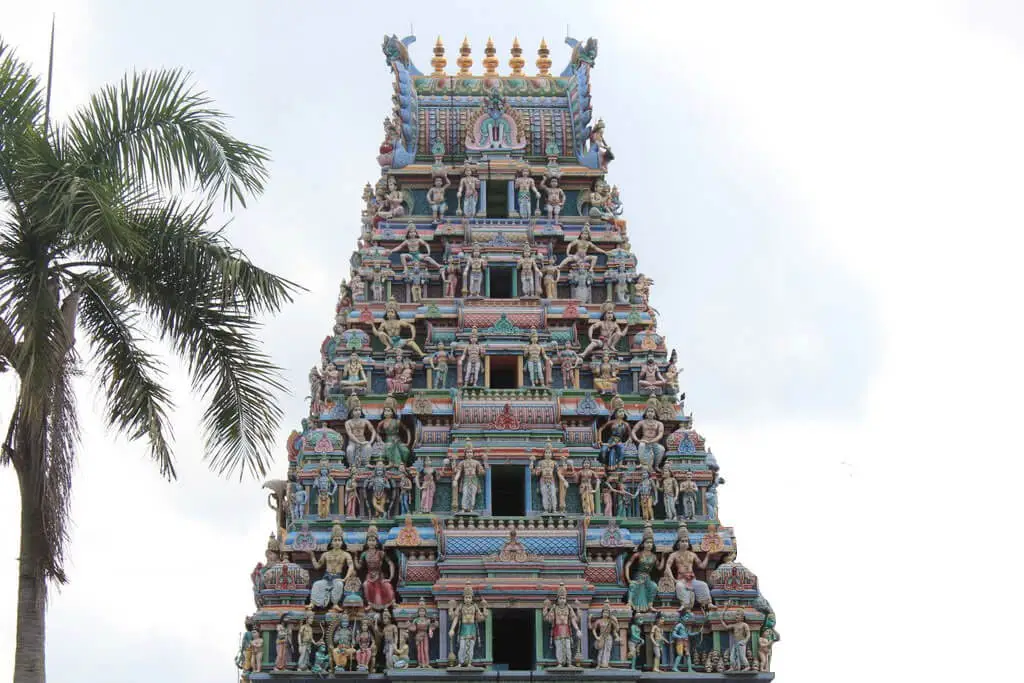



Blogs Top 5 Must-See Temples in Mayiladuthurai for First-Time Visitors

Mayiladuthurai is renowned for its ancient temples, many of which hold significant religious and historical importance. Here are five famous temples in and around Mayiladuthurai:
Deity: Lord Shiva (Mayuranathar)
Significance: This is the most famous temple in Mayiladuthurai, dedicated to Lord Shiva, where Goddess Parvati is believed to have worshiped Shiva in the form of a peacock (Mayil in Tamil). The temple is known for its beautiful architecture and rich history dating back to the Chola period.
Highlights: The temple’s stunning gopurams (tower), large courtyards, and intricate sculptures.
The temple is dedicated to Lord Shiva, worshipped as Mayuranathar.
The name "Mayuranathaswami" comes from the legend that Goddess Parvati performed penance here in the form of a peacock (Mayil) to seek Lord Shiva's blessings, hence the name "Mayiladuthurai" (Mayil – peacock, Thurai – place).
The temple features traditional Dravidian architecture, with a large gopuram (tower) and beautifully carved pillars.
It is adorned with intricate sculptures and carvings that depict scenes from Hindu mythology and epics.
The temple has historical roots dating back to the Chola dynasty, with contributions from later dynasties like the Pandyas and the Vijayanagar Empire.
Inscriptions found here provide insights into the temple’s rich heritage and royal patronage.
The temple is a major center during the Maha Shivaratri festival, which draws large crowds of devotees.
Other important festivals celebrated here include Navaratri and the Aani Thirumanjanam.
The temple has a holy tank called Kailasha Theertham, which is believed to have healing properties and is an important site for pilgrims to take a dip before entering the temple for darshan.
The temple is renowned for its serene and spiritually uplifting environment, attracting not only pilgrims but also those seeking peace and tranquility.
This temple is a prominent spiritual and architectural landmark in Mayiladuthurai, reflecting the town’s deep religious and cultural traditions.
Deity: Lord Vishnu (Parimala Ranganathar)
Significance: One of the 108 Divya Desams (sacred temples for Vaishnavites), this temple is dedicated to Lord Vishnu, who is believed to reside here as Parimala Ranganathar, reclining on the serpent Adisesha. The temple is located along the banks of the Cauvery River.
Highlights: Its ancient structure and sacred river setting make it a key pilgrimage destination.
The temple is dedicated to Lord Vishnu, worshipped as Parimala Ranganathar, in a reclining posture (Bhujanga Sayanam) on the serpent Adisesha.
It is one of the 108 Divya Desams, which are sacred pilgrimage sites for Vaishnavites as mentioned in the early Tamil literature Nalayira Divya Prabandham.
The temple is located on the banks of the Cauvery River, adding a scenic and serene environment to its spiritual significance.
It is believed that taking a dip in the river before visiting the temple brings spiritual purity.
The temple dates back to the Chola dynasty and has been further expanded by later rulers like the Vijayanagar kings and the Nayaks.
It features inscriptions that highlight the contributions of various rulers towards the maintenance and expansion of the temple.
The temple showcases Dravidian architecture, with a towering Rajagopuram (main gateway) and a large temple complex.
Intricate carvings and sculptures depict various forms of Lord Vishnu and mythological stories.
Parimala Ranganathar is known for the divine fragrance (Parimala) emanating from the temple, which is believed to purify the soul. This unique aspect adds to its sacredness, hence the name "Parimala" (meaning fragrance).
Vaikunta Ekadasi is the most important festival celebrated at the temple, drawing thousands of devotees who come to pass through the Vaikunta Dwaram (heavenly gates) for blessings.
Other festivals include Brahmotsavam, Garuda Sevai, and Panguni Uthiram.
The temple is praised in the hymns of Thirumangai Alvar and Nammalvar, adding to its significance in the Vaishnavite tradition.
Parimala Ranganathar Temple is an important spiritual destination for devotees of Lord Vishnu, known for its serene riverside setting and rich historical background.
Deity: Lord Shiva (Indaleeswarar)
Significance: Located in the Indalur area, this temple is another prominent Shiva shrine. The temple is believed to be the site where the sage Markandeya was saved by Lord Shiva from the god of death, Yama.
Highlights: The temple’s rich mythology, along with its serene and spiritually uplifting environment.
The temple is dedicated to Lord Shiva, worshipped as Indaleeswarar or Indalur Nathar, and his consort Goddess Parvati, worshipped as Sundaranayaki.
It is believed that Lord Indra, the king of the gods, worshipped Shiva here to be absolved of a curse, giving the place the name "Indalur" (Indra + Oor, meaning place of Indra).
The temple has ancient origins, with connections to the Chola dynasty and later contributions by the Pandyas and Vijayanagar Empire.
Historical inscriptions found in the temple provide evidence of royal patronage and religious donations to maintain the temple.
One of the significant legends associated with the temple is that sage Markandeya was saved from Yama (the god of death) by Lord Shiva at this temple, symbolizing victory over death.
The temple is associated with the belief that worshipping here helps devotees overcome the fear of death and attain peace.
The temple features traditional Dravidian architecture, with a large gopuram (tower), mandapams (halls), and beautifully carved pillars.
The inner sanctum houses a majestic lingam of Lord Shiva, with intricate carvings around the sanctum walls.
The Maha Shivaratri festival is celebrated with great devotion and grandeur, attracting thousands of devotees.
Other significant festivals include Margazhi Thiruvathirai and the Aadi Pooram dedicated to Goddess Sundaranayaki.
The temple has a sacred tank known as Indra Theertham, where devotees take a holy dip to cleanse themselves of sins before offering prayers to Lord Shiva.
Vallalar Koil is considered a spiritually potent temple for those seeking health, longevity, and relief from past sins. It is particularly popular among those seeking blessings for overcoming challenges related to mortality and health.
This temple holds great religious and mythological importance, making it a key pilgrimage site for devotees of Lord Shiva in the Mayiladuthurai region.
Deity: Lord Shiva (Punugiswarar)
Significance: This lesser-known temple is dedicated to Lord Shiva, worshipped as Punugiswarar. The temple has historical connections and is famous for the unique belief that a civet cat (Punugu) had worshipped Lord Shiva here.
Highlights: It has a unique, peaceful atmosphere with fewer crowds, offering a more intimate spiritual experience.
The temple is dedicated to Lord Shiva, worshipped as Punugiswarar.
It is believed that the name "Punugiswarar" is derived from the legend that a civet cat (Punugu in Tamil) worshipped Lord Shiva here, seeking blessings for the removal of its sins.
The temple has ancient origins, with links to the Chola dynasty and subsequent rulers who contributed to its maintenance and renovations.
Inscriptions found within the temple provide insights into its history and the significance of the site.
The temple features traditional Dravidian architecture, characterized by a prominent gopuram (tower) and intricately carved pillars.
The sanctum houses a unique lingam of Lord Shiva, surrounded by beautiful sculptures depicting various deities and mythological figures.
The temple is known for its peaceful and serene environment, making it an ideal spot for meditation and reflection.
Devotees often visit to seek blessings for peace of mind and spiritual growth.
The temple celebrates major Hindu festivals, particularly Maha Shivaratri, with elaborate rituals and celebrations that draw many devotees.
Other festivals celebrated here include Aadi Pooram and Margazhi Thiruvathirai.
Punugiswarar Temple is considered a sacred site for those seeking relief from past sins and spiritual cleansing.
It is especially popular among devotees looking for blessings in overcoming obstacles and achieving spiritual goals.
The temple is part of the local religious landscape and contributes to the cultural heritage of Mayiladuthurai, attracting both locals and pilgrims from afar.
This temple, though less prominent than some others, holds a unique charm and spiritual significance for those who visit.
Deity: Lord Shiva (Kalyanasundarar)
Significance: This temple is located near Mayiladuthurai and is famous for being a divine place for marriages and resolving marital issues. Lord Shiva is believed to have married Goddess Parvati here, making it a popular temple for couples seeking blessings for a harmonious relationship.
Highlights: Known for its role in helping couples overcome obstacles, the temple attracts pilgrims from across Tamil Nadu.
The temple is dedicated to Lord Shiva, worshipped as Kalyanasundarar. It also honors Goddess Parvati, worshipped here as Kalyanapiriya Devi.
It is believed to be the site where Lord Shiva and Goddess Parvati were married, making it a significant place for couples seeking marital harmony.
Thirumanancheri has ancient roots, with links to the Chola dynasty. The temple is rich in historical and cultural significance.
The temple features inscriptions that highlight its antiquity and royal patronage.
The temple showcases traditional Dravidian architecture, characterized by a towering gopuram (gateway) and intricately designed mandapams (halls).
The sanctum houses a beautiful lingam of Lord Shiva and intricate carvings that depict various deities and stories from Hindu mythology.
The temple is known for its unique rituals related to marriage, including special pujas for couples seeking blessings for a harmonious relationship.
Many devotees come to the temple to perform Kalyanam (marriage ceremony) with the divine couple as a way to seek blessings for their own marriages.
Major festivals celebrated here include Maha Shivaratri, Navaratri, and Panguni Uthiram, attracting large crowds of devotees.
The temple hosts special events during these festivals, with elaborate rituals and celebrations.
The temple features a sacred tank, which is believed to have purifying properties. Devotees often take a holy dip here before entering the temple.
Thirumanancheri Temple is a popular pilgrimage site for those seeking blessings for marital bliss and family harmony.
Its significance in Hindu mythology and the beautiful architecture make it an important destination for spiritual seekers.
This temple is not only a significant religious site but also a cultural landmark that embodies the rich heritage of the region.
These temples collectively represent the deep spiritual and cultural heritage of Mayiladuthurai.